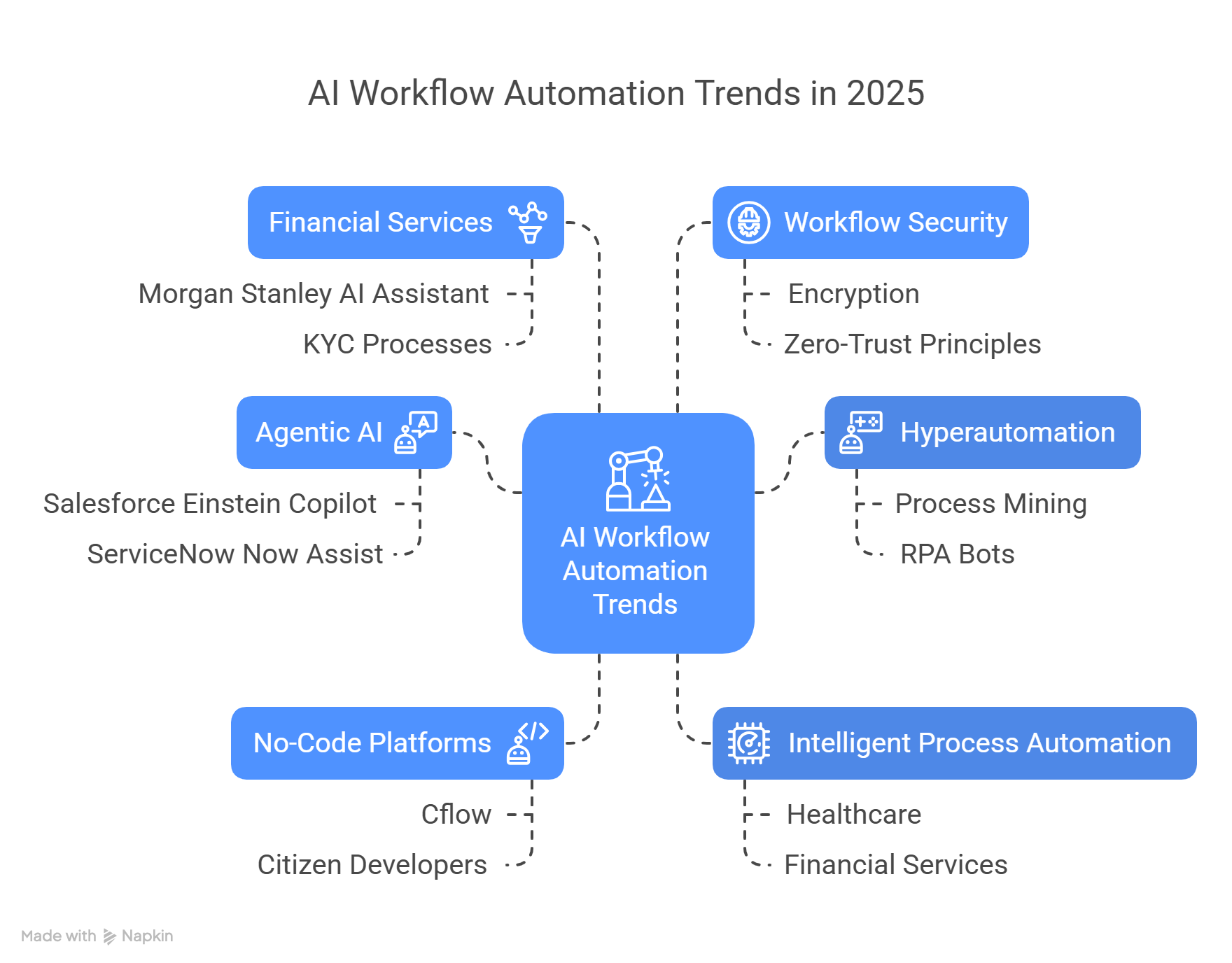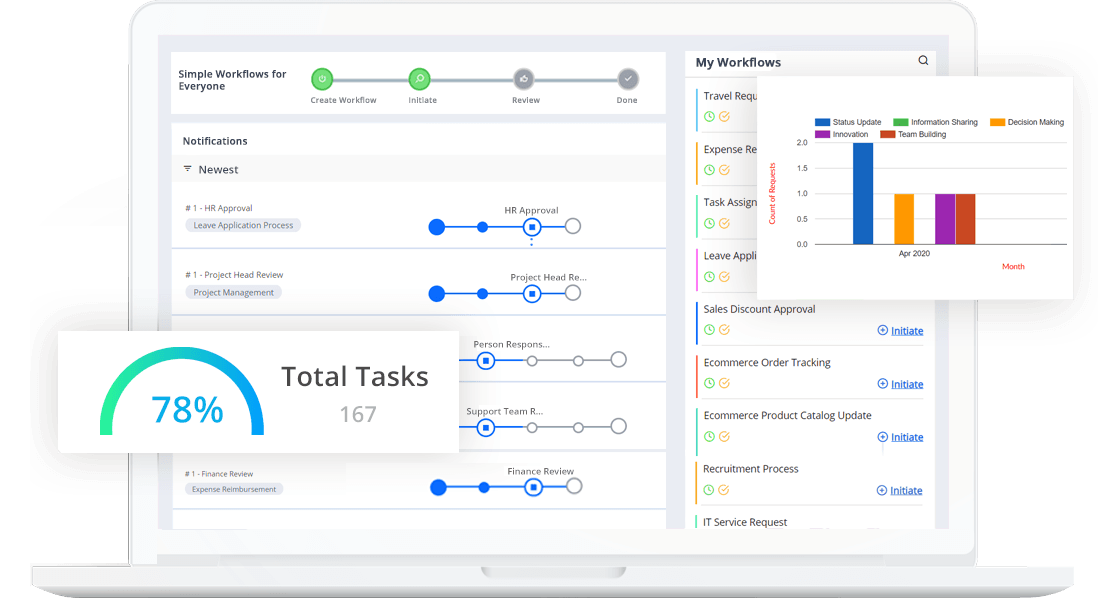AI Workflow Automation Trends for 2025: What Businesses Need to Know
Key takeaways
- Agentic AI is becoming mainstream in workflow automation, enabling intelligent decision-making without human intervention.
- Hyperautomation integrates AI, RPA, and ML for comprehensive, end-to-end process automation.
- Low-code and no-code platforms empower citizen developers to create workflows, accelerating digital transformation.
- AI workflow orchestration tools help businesses optimise and scale complex automation processes across departments.
- No-code platforms like Cflow democratize automation, empowering non-technical teams to build workflows and reduce IT backlog.
AI workflow automation is rapidly evolving from a supportive technology into a central force driving enterprise agility, cost efficiency, and innovation. In 2025, businesses are no longer simply automating repetitive tasks—they are reimagining operations through the lens of artificial intelligence. From agentic AI systems that make autonomous decisions to no-code platforms that democratize process automation, the AI landscape is redefining how organisations function across every department.
This transformation is not limited to large enterprises. Mid-sized businesses and startups are also tapping into AI to unlock faster processes, reduce operational overhead, and deliver superior customer experiences. As digital maturity increases across sectors, staying informed about the latest automation trends is no longer optional—it’s essential.
In this blog, we explore six key trends that will shape the future of AI workflow automation through 2024 and 2025, drawing on real-world examples, strategic implications, and industry-specific insights.
1. The Rise of Agentic AI in Workflow Design
One of the most exciting developments in AI workflow automation is the emergence of agentic AI—systems that function with a degree of autonomy, understanding intent, learning from context, and taking initiative without relying on predefined instructions. Traditional workflow automation has depended on triggers and rules to initiate actions. In contrast, agentic AI introduces a new level of sophistication by enabling systems to self-direct processes based on observed business goals, past patterns, and real-time inputs.
Agentic AI is already being incorporated into enterprise software platforms. Salesforce’s Einstein Copilot, for example, can proactively recommend workflow steps, summarise CRM data, and even initiate actions like follow-ups or opportunity escalations based on natural language cues. Similarly, ServiceNow’s Now Assist uses generative AI to pre-fill forms, suggest task assignments, and handle routine service requests without human initiation.
This evolution towards autonomous agents makes workflows far more adaptive and proactive. It reduces the need for manual configuration while enabling business processes to respond more effectively to change. In 2025, we can expect broader adoption of agentic AI in areas like customer service routing, internal operations, procurement, and project management—transforming workflows from linear processes into dynamic, context-aware systems.
2. Hyperautomation Becomes a Strategic Necessity
To compete in today’s environment, businesses must be able to analyse processes continuously, automate end-to-end workflows, and deliver outcomes faster than ever before.
Hyperautomation, which refers to the coordinated use of AI, machine learning, robotic process automation (RPA), and process intelligence, is transitioning from a technical trend into a boardroom-level strategy. Initially embraced to automate isolated tasks, hyperautomation now enables businesses to transform entire operational ecosystems by connecting disparate systems, streamlining decisions, and enhancing visibility across workflows.
Enterprises are increasingly deploying hyperautomation to achieve scale and efficiency. For instance, a global logistics firm may use process mining to identify delays in shipping operations, implement RPA bots to handle repetitive documentation, and use AI models to predict demand surges. Hyperautomation allows the business to integrate these components into a cohesive workflow that adapts in real time, resulting in faster deliveries and fewer manual interventions.
Gartner reports that 90% of large enterprises are prioritising hyperautomation initiatives.
3. No-Code Platforms Democratize AI Automation
Another major trend transforming the automation landscape is the rise of no-code platforms. These tools are enabling business users—often referred to as “citizen developers”—to create and deploy complex workflows without writing a single line of code. By removing the traditional barriers to automation development, no-code platforms accelerate innovation, reduce IT workload, and bring workflow customisation closer to the people who understand the process best.
Cflow is a leading example of a no-code platform built for AI-powered workflow automation. It offers an intuitive visual builder, drag-and-drop form designer, AI-powered field suggestions, and powerful integrations with business systems. In 2024, companies using platforms like Cflow are seeing measurable improvements in automation turnaround time, process visibility, and operational control.
The democratisation of automation is particularly valuable for fast-moving departments such as HR, procurement, and finance. Instead of waiting weeks for technical support, teams can now design onboarding flows, approval chains, or invoice validation systems independently.
Gartner predicts that by 2025, 70% of newly developed applications by enterprises will utilise low-code or no-code technologies, a significant increase from less than 25% in 2020.
As more organisations prioritise speed and flexibility, no-code platforms will continue to be central to digital transformation strategies in 2025.
4. Intelligent Process Automation Enables Real-Time Decision-Making
The Intelligent Process Automation market is experiencing rapid growth. It is projected to expand from $16.03 billion in 2024 to $18.09 billion in 2025, reflecting a compound annual growth rate (CAGR) of 12.9% .
Intelligent Process Automation (IPA) takes automation beyond rules and into the realm of decision-making. By integrating machine learning, natural language processing (NLP), and analytics directly into workflows, IPA enables systems to interpret data, respond to variations, and adjust outputs dynamically. This represents a major leap from static automation models.
In healthcare, for example, IPA is used to verify patient information, assess eligibility for treatment, and prioritise urgent care based on AI-driven scoring. In financial services, IPA enables real-time fraud detection and intelligent credit assessments, adjusting decisions as new data emerges. Retailers leverage IPA to forecast inventory demand, automatically reordering products or triggering supplier workflows when thresholds are met.
What sets IPA apart is its ability to learn and evolve. Over time, these systems improve decision accuracy, reduce the need for human intervention, and ensure faster service delivery. In 2025, IPA will be the foundation for critical workflows in customer experience, risk management, compliance, and logistics, providing organisations with a competitive edge rooted in operational intelligence.
5. AI Workflows in Financial Services Set the Benchmark
The financial services industry has long been at the forefront of adopting automation technologies, and in 2025, this sector is setting new benchmarks for AI workflow innovation. From regulatory compliance to customer onboarding, banks and financial institutions are using AI to speed up operations, reduce errors, and improve risk oversight.
One prominent example is Morgan Stanley’s internal AI assistant, designed to support financial advisors with instant insights, document generation, and task prioritisation. This agent is integrated into workflows that span client communication, investment planning, and compliance documentation—helping advisors make better decisions, faster.
Beyond internal use cases, banks are also using AI-powered automation to streamline KYC (Know Your Customer) processes, automate loan underwriting, and generate real-time financial reports for regulators. These workflows not only reduce administrative overhead but also ensure accuracy and transparency, critical for maintaining trust in a heavily regulated environment.
As AI capabilities expand, we can expect financial institutions to lead the development of secure, explainable, and audit-friendly workflows that serve as blueprints for other industries adopting automation.
6. Workflow Security Is Built In
As AI workflows evolve, so do the risks associated with their complexity and scale. Traditional security models that treat automation as an afterthought are no longer viable. Instead, leading organisations in 2025 are building security directly into their automation architecture—a shift known as security-by-design.
Modern AI workflows deal with sensitive data, including personal identifiers, financial records, and proprietary documents. To safeguard this information, organisations are embedding encryption, identity verification, access controls, and anomaly detection mechanisms at every stage of the workflow lifecycle. Zero-trust principles are becoming standard, requiring continuous authentication and strict policy enforcement within workflows.
Platforms like Cflow are also responding to this shift by offering features such as role-based access, secure audit trails, and automated compliance alerts. These capabilities are particularly important for businesses in healthcare, banking, insurance, and government sectors, where a single data leak can result in regulatory penalties and reputational damage.
By treating security as a foundational component, businesses can scale AI automation confidently—knowing their data, users, and systems are protected by design.
Cflow’s Role in Shaping AI Workflow Automation
As AI transforms how businesses automate and scale operations, Cflow stands out as a powerful no-code platform that aligns perfectly with 2025’s automation trends. By combining intelligent design, security, and seamless integration, Cflow helps organisations build adaptive, future-ready workflows with minimal effort.
AI-Powered Field Creation
Cflow’s Seyarc AI simplifies workflow design by auto-generating form fields from process descriptions, reducing setup time and eliminating manual errors.
Visual Workflow Builder
Users can visually map out complex workflows using a drag-and-drop interface—making automation design faster, more intuitive, and fully customizable.
Seamless Integrations for Hyperautomation
With built-in connectors for RPA tools, cloud platforms, and third-party apps, Cflow supports full-scale hyperautomation across departments.
Role-Based Access and Security
Cflow offers enterprise-grade security features, including role-based access control, audit logs, and encryption, ensuring data integrity and compliance.
No-Code Customisation for Citizen Developers
Business users can independently create, modify, and deploy workflows without coding, accelerating automation adoption across teams.
Mobile Accessibility for Real-Time Approvals
The Cflow mobile app enables workflow actions on the go—ensuring speed and continuity in hybrid work environments.
Conclusion
Automation-first businesses will lead the future. The trends we discussed indicate a future where automation is strategic and deeply embedded in business models. Organisations that embrace these trends will not only reduce operational friction but also unlock new levels of agility and intelligence. The key lies in combining human expertise with AI capabilities to design workflows that adapt, learn, and deliver. Now is the time to audit your automation strategy, explore AI capabilities, and prepare your organisation to thrive in an intelligent automation era.
Cflow empowers you to take that next step with ease. With its AI-powered, no-code platform, Cflow helps you build secure, adaptive workflows tailored to your unique business needs. Start your automation journey with Cflow today and lead the future of work. Sign up for a free trial.
FAQs
1. What is the next big thing in automation?
The next big thing is agentic AI—systems that can understand goals and autonomously execute workflows, revolutionising how automation operates.
2. What is the future of intelligent automation?
Intelligent automation will integrate AI, analytics, and decision-making into workflows, enabling real-time adaptability and reducing manual oversight.
3. Will AI replace RPA?
AI will not replace RPA but will enhance it. Together, they form the core of hyperautomation—expanding automation from task-level to strategic process-level.
4. How many jobs will be replaced by automation by 2025?
While exact numbers vary, studies estimate that millions of jobs may be automated, especially repetitive ones, but many new roles in AI oversight and workflow design will emerge.
5. What is the future of RPA in 2025?
RPA will evolve from standalone task automation to being part of broader hyperautomation frameworks, powered by AI, analytics, and intelligent decision-making tools.



